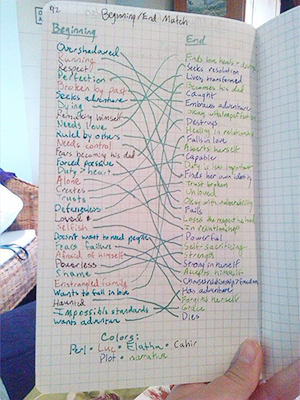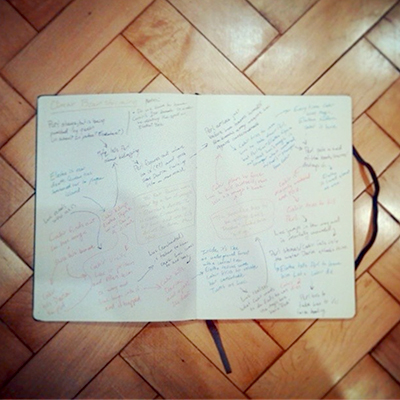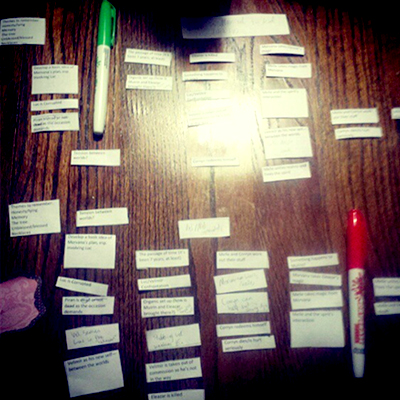I have friends who absolutely love writing their story’s climax. It’s their favorite part of the writing process.
I am not one of those people.
The thought of writing a climax makes me want to do my laundry. I would rather clean the hair out of my drain than start drafting my climax. I cannot tell you how spotless my house gets when I reach the latter third of my novel.
The first draft of my climaxes (and everyone’s, I’d hazard) are terrifyingly awful. But this time around, I wanted to put in work beforehand to help save on rewrites after. Below are the five ways I’ve tried to make my approaching climax (*coughsplutter*) fun.
1. Interviews and Questionnaires
K.M. Weiland is one of my favorite bloggers, and her series on creating stunning character arcs has been awesome. I find myself going back to this whenever I get stuck. In addition to having some cool advice, she also includes questionnaires at the end of her posts to help prod you into writing mode.
I went through her third plot point, climax, and resolution posts to help warm me up. I filled out the questions for my three main characters. This helped me find some gaps in the story, and got the gears turning about the actual events that needed to happen in the climax.

2. Journal Games
I’ve written previously about character arcs. Well, I felt the need to review my familiarity with my characters’ arcs as I began to think about writing the climax.
One of the productive procrastination activities I’ve done in my novel journal is list the characteristics/circumstances of my characters at the beginning of the novel in a lefthand column, and then listed their CHANGED characteristics/circumstances on the righthand side. Then I played a matching game drawing lines across the page.
I went a little extra crazy and used different colored pens for each of the different characters and different colors for changes that happened in plot vs. in narrative (i.e. changes that happen because of external circumstances and changes that happen within a character him/herself).
So basically what I’ve done (hypothetically) is:
Beginning: Ginger cannot dance the tango -> End: (Plot change) Ginger learns the tango
Beginning: Jim needs control -> End: (Narrative change) Jim finds strength in vulnerability
Except I’ve done it with lots of color and lines and things.
This was a good way to visually remind myself of my characters’ journeys and to gear up for writing the ultimate change in the last several chapters.

Cause and Effect (in Colors!)
When it was time to seriously start thinking about the climax, I pulled out my big novel journal (aka a sketchbook) and my many colored pens. I assigned a pen to each character and started writing out what each character was up to, with arrows connecting them.
By doing this, I found out that I knew more about what needed to happen than I thought. I tried to take the things I’d learned about them in the interviews and turn it into concrete actions. It was also helpful to do this in shorthand (instead of drafting) because my brain had more room to work and come up with creative solutions and less room to be freaking out.
The climax ended in a place I wasn’t expecting, but which has me totally pumped for writing it!

The “Rearrange It” Challenge
I took this idea from Marissa Meyer’s major revision post (its organizational structure speaks to me on a spiritual level) and simplified it.
When I was rewriting the climax in Blessings, I took the basic things I knew needed to happen and I put them in Word. Then I printed out three copies and cut them into squares.
I took these to my dining room table and made myself order my events in three completely different ways (all of them different from the [terrible] draft I already had). The Blessings climax also has a location change, so I made that change happen in a different spot for all three versions.
Once these were laid out, I took pictures of each of them, then analyzed which orders I liked and did a bit more rearranging. Once I had that down, I basically had my climax outline. (I’m planning to do this once with my Illuminate outline before I draft it, but I do anticipating doing it again once I’ve got a first draft.)
Revise the Beginning
When you prep for the climax, it’s helpful to go back to the beginning and review how everything started. Sometimes I find surprising (and fun) mirroring opportunities. Often it’s just good to remind myself what questions kicked the book off, so I know what to focus on when the book comes to a close.
So there you have it! I guess I should go actually write my climax instead of blogging about writing it… Or maybe I’ll go wipe down my shower. Yeah, that sounds like a good idea.

















